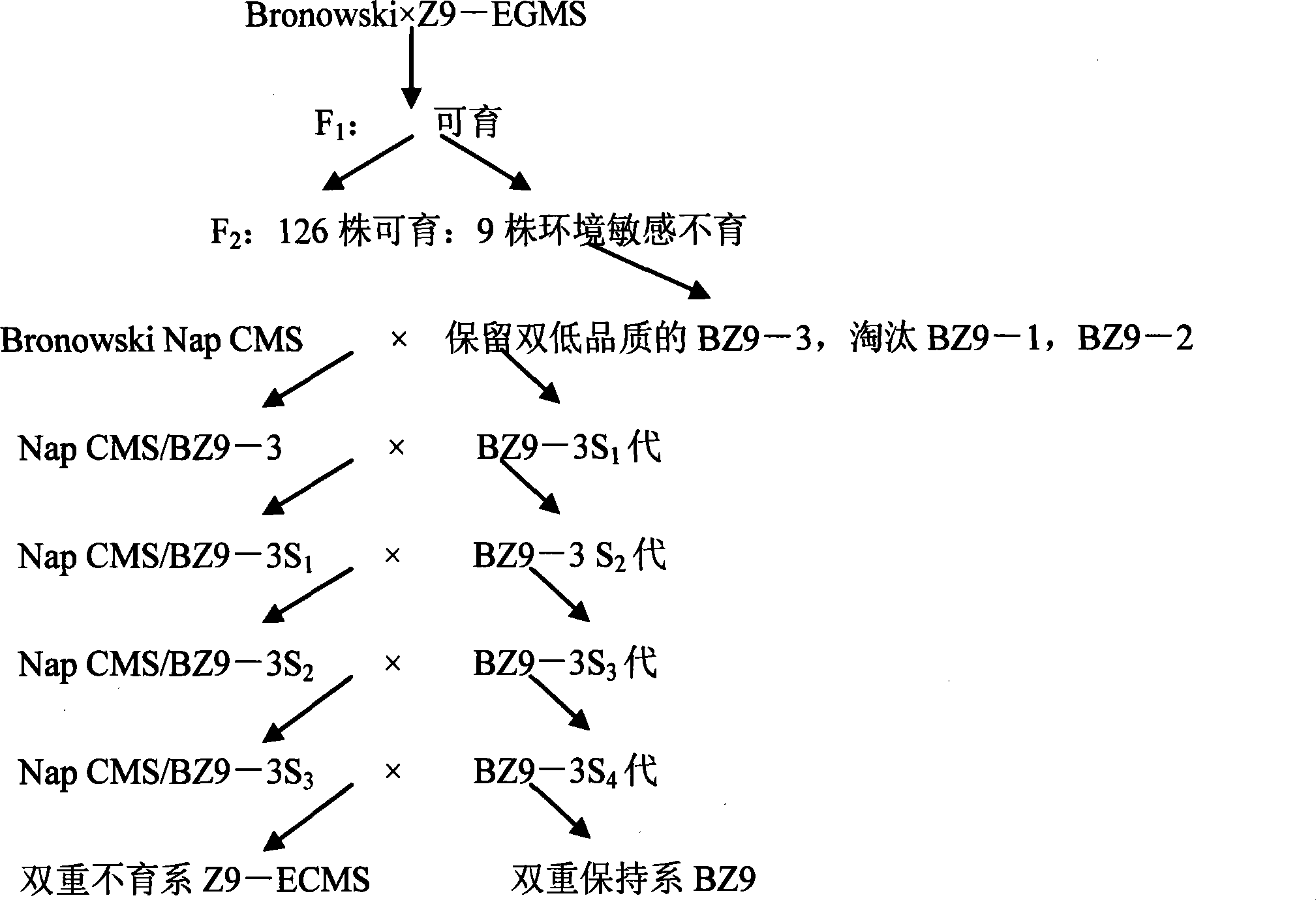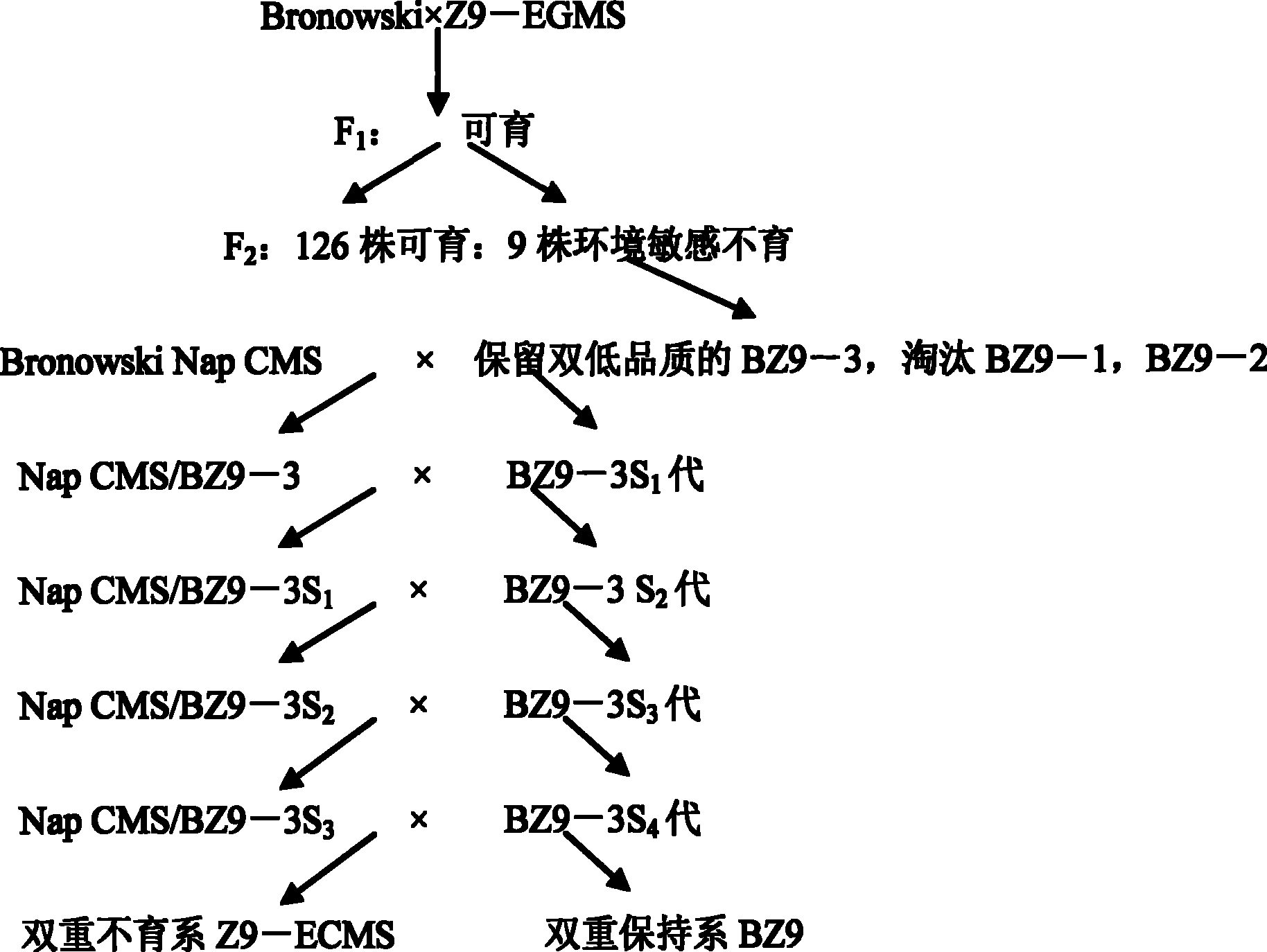Seed selection method of cabbage type rape twofold sterile line
A cabbage type rapeseed double technology is applied in the field of crop heterosis utilization, can solve the problems of high risk and strictness of seed production failure, and achieves the effects of improving purity, stable flowering period fertility and increasing yield
- Summary
- Abstract
- Description
- Claims
- Application Information
AI Technical Summary
Problems solved by technology
Method used
Image
Examples
Embodiment 1
[0034] The sterile line, code-named BronowskiNap CMS, was obtained by continuous backcrossing of the Canadian variety AC Elect by Bronowski.
[0035] Using an environmentally sensitive sterile line 373S selected and bred (China Agricultural Science Bulletin, 2007, (7): 255-258, this sterile line has been planted and identified in Qinghai Academy of Agriculture and Forestry Sciences, Yangzhou Institute of Agricultural Sciences, Shanxi Academy of Agricultural Sciences, etc. , and donated to relevant units to carry out breeding application research) to cross with the variety Zhongshuang 9, F 1 Daizai and Zhongshuang No. 9 were backcrossed, using BCF 2 Environmentally sensitive sterile strains isolated from successive generations were continuously selfed to obtain the environmentally sensitive sterile line Z9-EGMS. The breeding line Z9-EGMS was sown in autumn in Yangling, Shaanxi and other places. The fertility performance of the flowering period is the same as that of 373S. It i...
Embodiment 2
[0041] The temperature-sensitive male sterile two-line hybrid Xiangzayou No. 5 bred from the Crop Research Institute of the Hunan Academy of Agricultural Sciences (variety approval number: National Examination Oil 2003011, approved by the Hunan Provincial Crop Variety Approval Committee in 2002, the original code 9705 , Variety source: Xiang 91S × Zhongshuang 4. Chinese Journal of Oil Crops. 2005 (3): 74-76) an environmentally sensitive male sterile line Xiang5S was isolated from the offspring.
[0042] The environmentally sensitive male sterile line Xiang5S was used as the male parent to cross with the maintainer line Bronowski of Nap CMS (glucosinolate2 Two environmentally sensitive sterile strains were isolated from 178 strains. Using these two environmentally sensitive sterile lines as male parents to testcross BronowskiNap CMS, one line can partially maintain CMS. Eleven plants were selected from the self-bred progeny of this environmentally sensitive sterile plant, and t...
Embodiment 3
[0043] Embodiment 3: Double sterile line and other sterile line comparative test of fertility
[0044] Experiments were carried out in the Yangling area of Shaanxi Province, where the double sterile line Z9-ECMS, the double sterile maintainer line BZ9, the environmentally sensitive GMS line Z9-EGMS and Bronowski Nap CMS were sown in autumn.
[0045] 10 plants are randomly selected in the flowering period of the next year, and 10 fresh flowers in different parts are taken from each plant, the anthers are extruded to release the pollen, stained with acetic acid carmine, and the active pollen (ellipse in shape, complete in shape, capable of being dyed) is counted under a microscope. red) percentage.
[0046] Another 10 bagged plants were selected for self-fertilization, and the self-seed setting rate was calculated relative to the normal varieties Zhongshuang 9 and Bronowski, and the male fertility of the entire flowering period was estimated. The results showed that the ferti...
PUM
 Login to View More
Login to View More Abstract
Description
Claims
Application Information
 Login to View More
Login to View More - R&D
- Intellectual Property
- Life Sciences
- Materials
- Tech Scout
- Unparalleled Data Quality
- Higher Quality Content
- 60% Fewer Hallucinations
Browse by: Latest US Patents, China's latest patents, Technical Efficacy Thesaurus, Application Domain, Technology Topic, Popular Technical Reports.
© 2025 PatSnap. All rights reserved.Legal|Privacy policy|Modern Slavery Act Transparency Statement|Sitemap|About US| Contact US: help@patsnap.com


